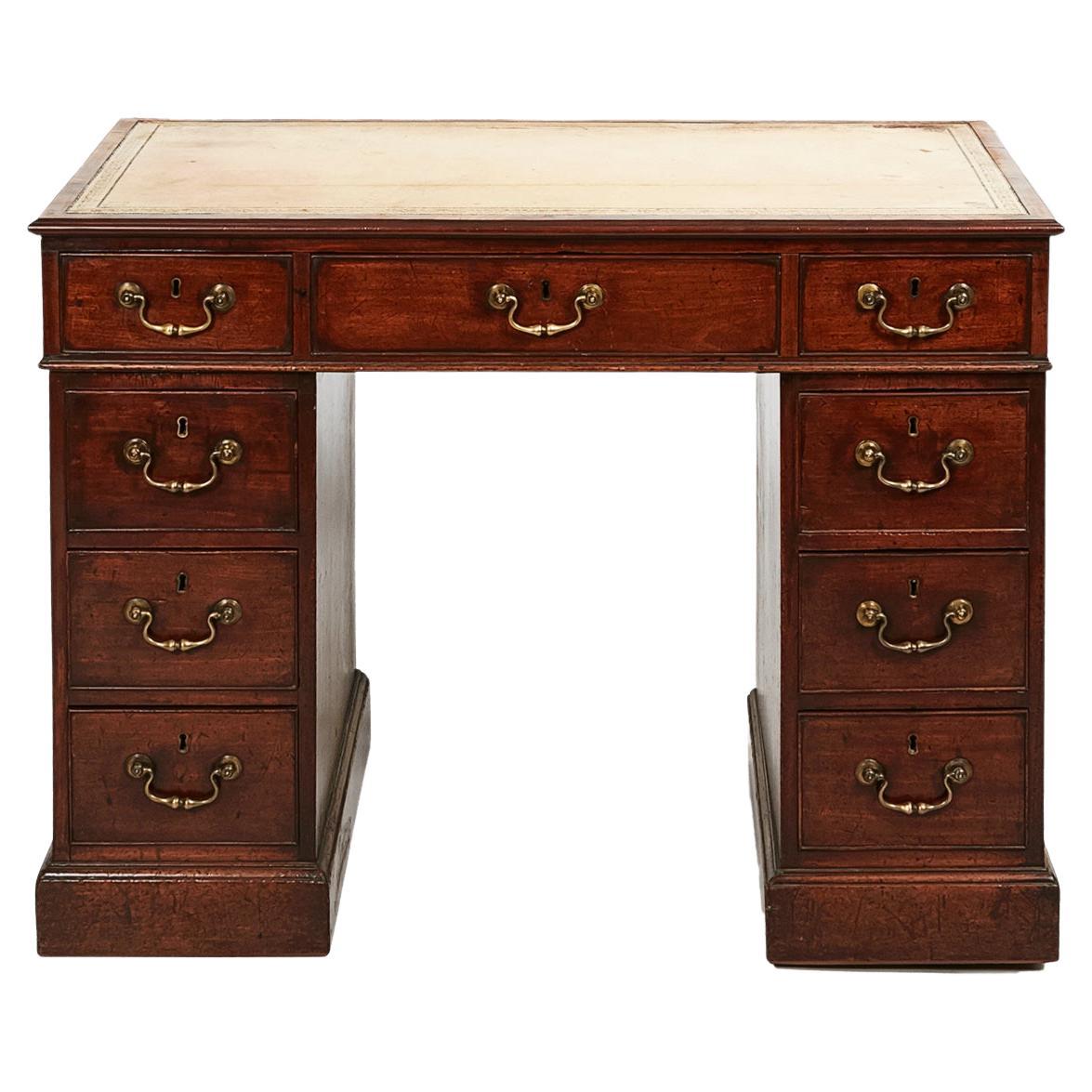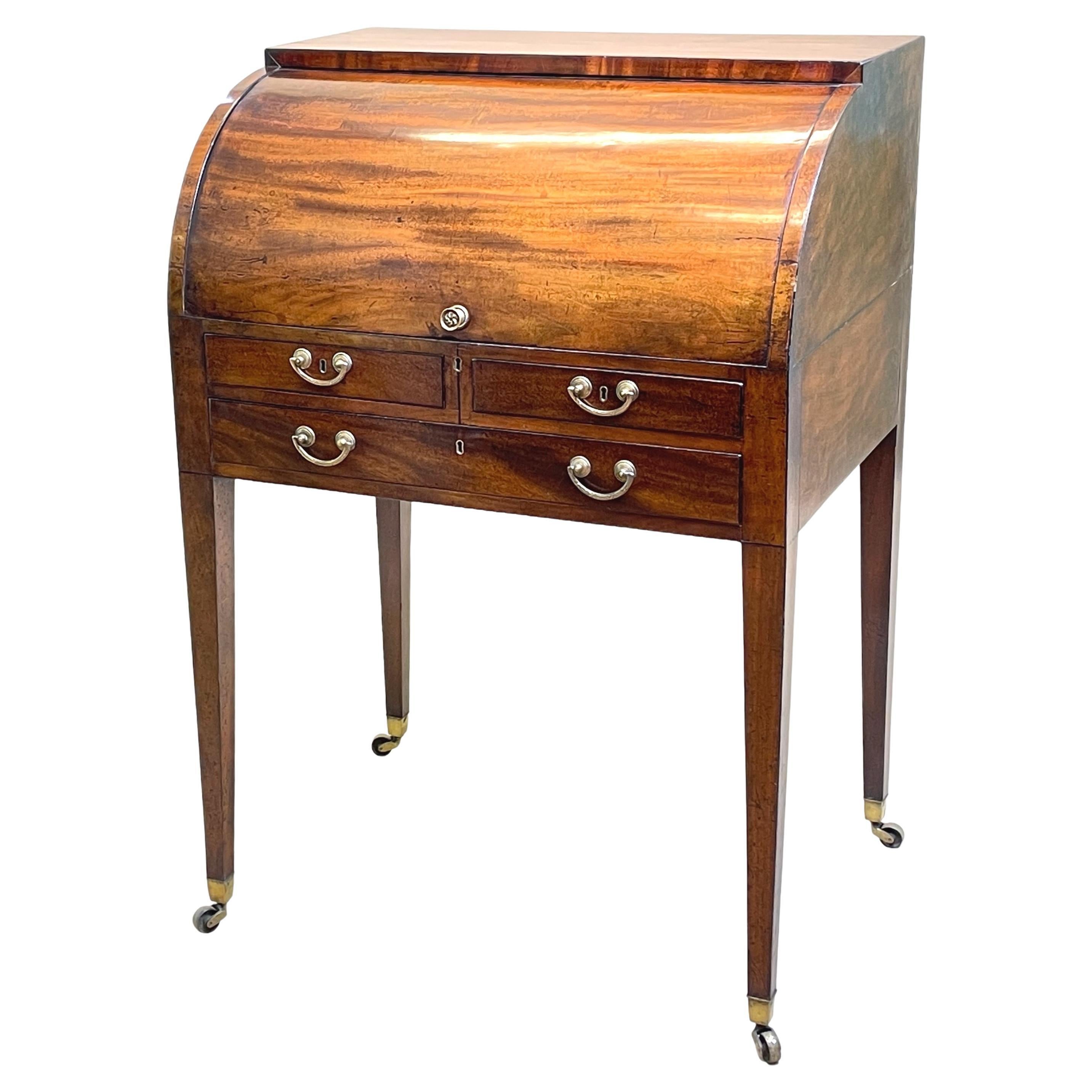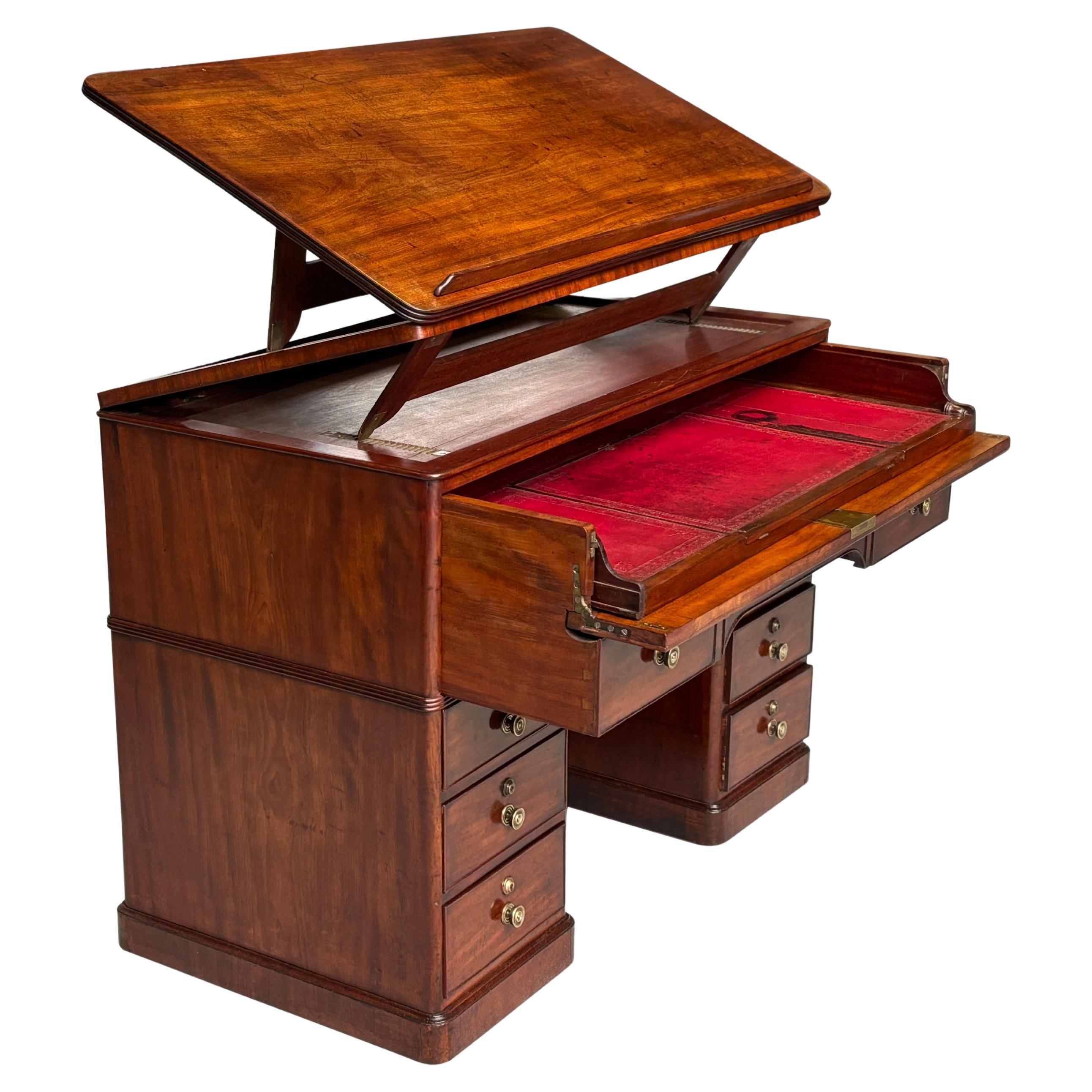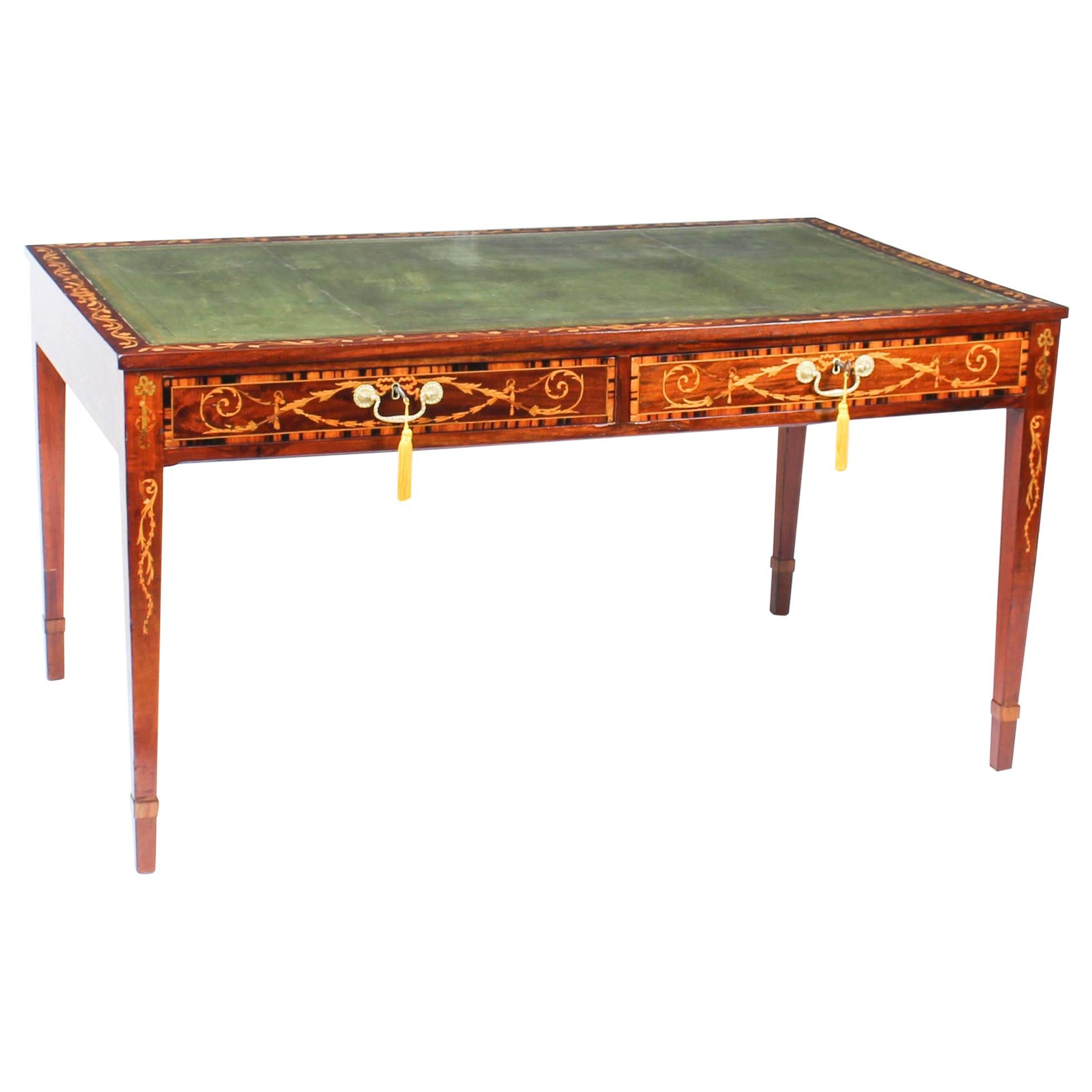Items Similar to 18th Century Mahogany Desk
Want more images or videos?
Request additional images or videos from the seller
1 of 5
18th Century Mahogany Desk
About the Item
A George III period mahogany kneehole desk of good size, with the original brasses and lovely one piece top. The whole piece is of great colour and patina, circa 1780
This desk is very good to sit at with the kneehole having a narrow cupboard at the back allowing a chair to easily be placed beneath.
- Dimensions:Height: 29.93 in (76 cm)Width: 48.04 in (122 cm)Depth: 25.99 in (66 cm)
- Style:George III (Of the Period)
- Materials and Techniques:
- Place of Origin:
- Period:1780-1789
- Date of Manufacture:circa 1780
- Condition:Wear consistent with age and use.
- Seller Location:Lincolnshire, GB
- Reference Number:1stDibs: LU917618771842
About the Seller
5.0
Vetted Seller
These experienced sellers undergo a comprehensive evaluation by our team of in-house experts.
Established in 1972
1stDibs seller since 2011
33 sales on 1stDibs
Typical response time: 1 hour
Associations
The British Antique Dealers' AssociationLAPADA - The Association of Arts & Antiques Dealers
- ShippingRetrieving quote...Ships From: Lincolnshire, United Kingdom
- Return PolicyThis item cannot be returned.
More From This SellerView All
- Fine 18th Century Mahogany Free Standing Library DeskLocated in Lincolnshire, GBA fine quality late 18th century mahogany free standing library desk, the flame mahogany cupboards with ebony fluting to the sides of the kneehol...Category
Antique 18th Century English Georgian Desks and Writing Tables
MaterialsMahogany
- Mid-18th Century Mahogany LowboyLocated in Lincolnshire, GBA lovely example of a Georgian mahogany lowboy with cabriole legs and carved scolls, original handles and great colour and patination.Category
Antique Mid-18th Century English Georgian Lowboys
MaterialsMahogany
- 18th Century Mahogany Wine TableLocated in Lincolnshire, GBAn elegant 18th century mahogany tripod or wine table with reeded column and carved cabriole legs, good color and patina.Category
Antique 18th Century English Side Tables
MaterialsMahogany
- George III Period Mahogany Fitted Desk Attributed to Gillows of LancasterBy Gillows of Lancaster & LondonLocated in Lincolnshire, GBAn 18th century mahogany desk or sometimes called architects desk, with fitted top drawer containing a baize lined wiring surface below which is a fitted section contains alphabet inlaid letter boxes The double top drawer slides out on hidden rollers and the baize section then slides back. Original swan neck brass handles and fine flame mahogany. finished with dummy drawers to the back making this a free standing desk. A model is in the Gillow design...Category
Antique 18th Century English Desks
MaterialsBrass
- A Fine 18th Century Mahogany Bell Top Bracket ClockLocated in Lincolnshire, GBAn 18th century mahogany and ormolu mounted bell top bracket clock. The 8-day movement with finely engraved back plate and the full brass dial signed Pennington, Drury Lane Circa 178...Category
Antique Late 18th Century English Georgian Table Clocks and Desk Clocks
MaterialsBrass, Ormolu
- Mid-18th Century Mahogany Corner ChairLocated in Lincolnshire, GBA large example of a mid 18th century mahogany corner chair with vase shaped back splat, good cpouor and patination.Category
Antique Mid-18th Century English Corner Chairs
You May Also Like
- 18th Century George III Mahogany Pedestal DeskLocated in Dublin 8, IE18th century George III mahogany pedestal desk. With green-leather top and large centred drawer flanked by two smaller drawers, abov...Category
Antique Late 18th Century English George III Desks and Writing Tables
MaterialsMahogany, Leather
- 18th Century Mahogany Cylinder DeskLocated in Bedfordshire, GBA very good quality late 18th century Georgian mahogany cylinder desk having well figured roll top, enclosing baize sliding writing surface with...Category
Antique Mid-18th Century English Georgian Desks
MaterialsMahogany
- 18th Century George III Period Mahogany Partners DeskLocated in Petworth,West Sussex, GBA stunning late 18th century George III period mahogany partners desk. Nine oak lined drawers to one side and three oak lined drawers and two cupboards to the other side. A golden green colour tooled leather inset to top with thumb moulded edge over two pedestals, all drawers with a pair of original brass ring handles, all standing upon a plinth base with brass castors. Good height! Exceptional quality with a lovely warm original patina. The dimensions are: Height: 87cm (34.3in) Width: 168cm (66.1in) Depth: 97cm (38.2in) This late 18th century, George III period antique solid mahogany desk...Category
Antique 18th Century British George III Desks and Writing Tables
MaterialsLeather
- 18th Century George III Period Mahogany Architect's DeskBy Gillows of Lancaster & LondonLocated in Petworth,West Sussex, GBA stunning late 18th century, George III period solid mahogany architect's desk. Finished in the round, the top slants up for reading, or cantilevers up for either reading or writing...Category
Antique Late 18th Century British George III Desks and Writing Tables
MaterialsBrass
- 18th Century Antique Mahogany Kneehole DeskLocated in Martlesham, GB18th Century mahogany kneehole desk, having a wonderfully figured moulded edge top above a selection of seven drawers with the original brass plate handles and escutcheon, hinged cup...Category
Antique 1780s British Georgian Desks and Writing Tables
MaterialsMahogany
- Antique George III Mahogany Library Writing Table Desk, 18th CenturyLocated in London, GBThis is a fine antique George III mahogany and marquetry library table, circa 1780 in date. The table features beautiful floral and scrolling foliate marquetry throughout, with flame mahogany marquetry panels and gonçalo alves crossbanding. The rectangular top is fitted with the original emerald green gold tooled inset leather writing surface above a pair of crossbanded frieze drawers, raised on square tapered legs. It is freestanding, finished on all sides, so that it can stand freely in the middle of a room, making it extremely suitable for a large home or office. Complete with original brass handles, working locks and keys. THE BOTANICAL NAME FOR THE MAHOGANY THIS ITEM IS MADE OF IS SWIETENIA MACROPHYLLA AND THIS TYPE OF MAHOGANY IS NOT SUBJECT TO CITES REGULATION. Condition: In excellent condition having been beautifully cleaned, polished and waxed in our workshops, and only shows minor signs of wear commensurate with age and use. Please see photos for confirmation. Dimensions in cm: Height 76 x width 144 x depth 84 Dimensions in inches: Height 29.9 x width 56.7 x depth 33.1 Marquetry is decorative artistry where pieces of material (such as wood, pewter or brass silver) of different colours are inserted into surface wood veneer to form intricate patterns such as scrolls or flowers. The technique of veneered marquetry had its inspiration in 16th century Florence. Marquetry elaborated upon Florentine techniques of inlaying solid marble slabs with designs formed of fitted marbles, jaspers and semi-precious stones. This work, called opere di commessi, has medieval parallels in Central Italian "Cosmati"-work of inlaid marble floors, altars and columns. The technique is known in English as pietra dura, for the "hardstones" used: onyx, jasper, cornelian, lapis lazuli and colored marbles. In Florence, the Chapel of the Medici at San Lorenzo is completely covered in a colored marble facing using this demanding jig-sawn technique. Techniques of wood marquetry were developed in Antwerp and other Flemish centers of luxury cabinet-making during the early 16th century. The craft was imported full-blown to France after the mid-seventeenth century, to create furniture of unprecedented luxury being made at the royal manufactory of the Gobelins, charged with providing furnishings to decorate Versailles and the other royal residences of Louis XIV. Early masters of French marquetry were the Fleming Pierre Golle and his son-in-law, André-Charles Boulle, who founded a dynasty of royal and Parisian cabinet-makers (ébénistes) and gave his name to a technique of marquetry employing brass with pewter in arabesque or intricately foliate designs. Flame mahogany Thomas Sheraton - 18th century furniture designer, once characterized mahogany as "best suited to furniture where strength is demanded as well as a wood that works...Category
Antique 1780s English George III Desks and Writing Tables
MaterialsLeather, Mahogany
Recently Viewed
View AllMore Ways To Browse
Great Antique Desk
18th Writing Desk
18th Century Writing Desk
Mahogany Table And Chairs
Lovely Antique Desk
Used Mahogany Table And Chairs
Kneehole Desk
Kneehole Desks
George Writing Desk
Writing Cupboard
Mahogany George Desk
Period Desk Chairs
Narrow Mahogany
Writing Desk Kneehole
Mahogany Office Desk Chair
Narrow 18th Century Furniture
Kneehole Desk Antique
Kneehole Desk Antique Furniture





